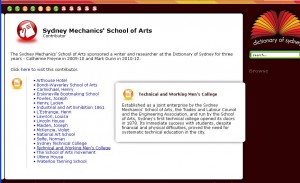The Dictionary of Sydney was archived in 2021.
New content in the Dictionary

- William Charles Windeyer – lawyer and public man, a stalwart of the Sydney Mechanics.
- Peter Nicol Russell – pioneering engineer and manufacturer who endowed the School of Engineering at the University of Sydney.
- George Kenyon Holden – lawyer and parliamentarian who reformed land title in NSW.

- Walter Renny – oil and colour man, who was mayor of Sydney in 1869-70
- Elizabeth Kata – the writer of the book upon which the film 'A Patch of Blue' was based, whose family was divided by World War II and its aftermath
- John Lucas – son of convicts who became a parliamentarian and the protector of Jenolan Caves
Finding your way through the Dictionary, part 5


Finding your way through the Dictionary, part 4




Finding your way through the Dictionary, part 3

Hidden journeys, uncovered



Finding your way through the Dictionary, part 2
So you've read entries, and you've followed some links between entities. What else does the Dictionary have to offer? How about images?
Images are connected into entries where they illustrate the stories our authors tell about Sydney's history. In situ, they appear to the left of the text at thumbnail size, and larger when you roll over them.
Rolling over an image means you can see the caption we've written, specifically for this placement in this article. The picture might be used again somewhere else for a different purpose.
But did you know you can see a bigger version of the image, along with all the collection details, if you click on it?
This view shows you everything we have about this image, including where it is, along with any reference numbers.
In the right column, are links to the entries it has been used in, each with an independent caption.
Some institutions, such as the State Library of NSW, have amazing riches in their image collections, which they've been generous enough to share with the Dictionary. And our research into Sydney's people has fed back into their catalogues too, as we are happy to help if we find information that we can add to their dating or provenance.
It's also possible to browse the Dictionary's multimedia, using the browse Multimedia link on the front page. This brings up a list of all the 2,400 images and multimedia in the Dictionary. Use Ctrl-F to search for particular words in titles. (Actually, Ctrl-F, which brings up a Find window to search for words anywhere on the current page, is just about the most useful shortcut for internet searching that there is. On any page.)
The list of images and multimedia gets longer with every rebuild, and we are currently working on a subject index to it, so stay posted!
Other posts in this series:
Finding your way through the Dictionary part 1 -- Entities
Finding your way through the Dictionary part 2 -- Images
Finding your way through the Dictionary part 3 -- Maps
Finding your way through the Dictionary part 4 -- Contributors
Finding your way through the Dictionary part 5 -- Demographics
Finding your way through the Dictionary part 6 -- Roles
Finding your way through the Dictionary part 7 -- Subjects
Finding your way through the Dictionary part 8 -- Bonus extras
From the ground up

International Lighthouse Weekend


Homebush, talking

National Bookshop Day












